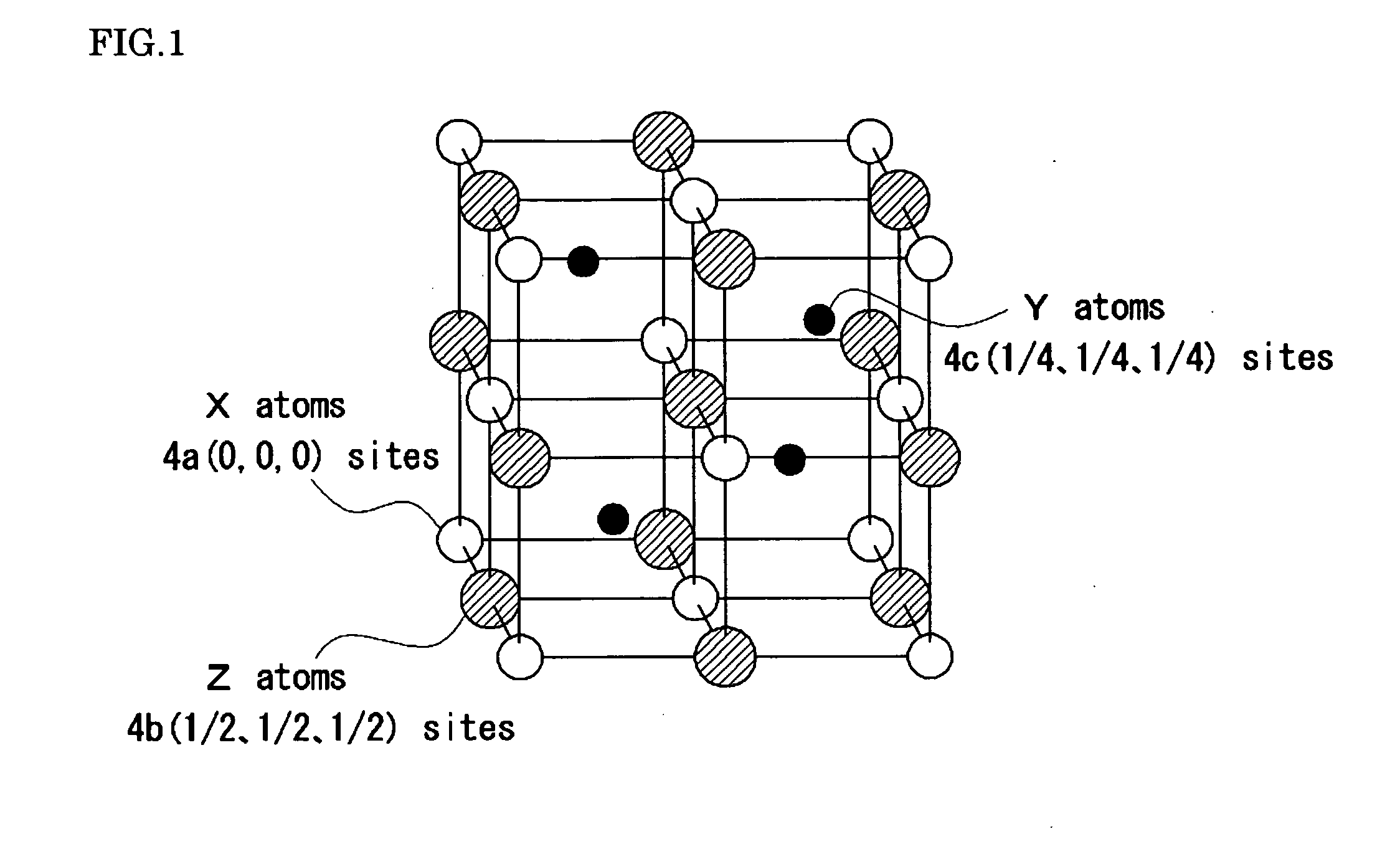Thermoelectric material and method of manufacturing the material
a technology of thermoelectric materials and manufacturing methods, which is applied in the direction of thermoelectric device junction materials, thermoelectric devices, electrical apparatus, etc., can solve the problems of compound semiconductors containing large amounts of expensive ge, compound semiconductors with limits in reachable merit figures, etc., and achieve rapid solidification, reduce thermal conductivity , increase the power factor pf
- Summary
- Abstract
- Description
- Claims
- Application Information
AI Technical Summary
Benefits of technology
Problems solved by technology
Method used
Image
Examples
example 1
1. Production of Samples
[0198]Ti (purity: 99.9% or more), Ni (purity: 99.9%) and Sn (purity: 99.9% or more) were weighed such that their feed values could produce Ti1−αNi1−αSn (−0.05≦α≦0.05) or TiNi1+βSn (−0.01≦β≦0.03). These were placed into a crucible made of boron nitride, and then placed in a high frequency induction furnace. After evacuating the inside of the furnace to 10−3 Pa range, Ar gas was introduced until the internal pressure within the chamber was raised to 0.34×105 Pa. Subsequently, high frequency current was applied to a coil such that the raw material in the crucible was melted. After the material was melted, the resultant molten metal was furnace cooled to obtain an ingot.
[0199]The resultant ingot was remelted within a pipe made of boron nitride, and then the molten metal was rapidly cooled on a Cu roll surface rotating at 3000 rpm to obtain a ribbon-shaped sample. The sample was ground and then sintered under a pressure of 50 MPa at 1100° C.×15 minutes by using a ...
example 2
1. Production of Samples
[0214]In order to substitute the relevant sites of the sample 6 of Example 1 as a base material, the following weighing was performed:
(1) The Sn sites thereof were to be substituted with Sb (up to 1%);
(2) The Ni sites thereof were to be substituted with Cu (up to 0.5%); or
(3) The Sn sites thereof were to be substituted with Sb, and the Ti sites thereof was to be substituted with Y whose amount was the same as that of Sb (up to 3%). The purities of Sb, Cu and Y thus used are 99.9% or more, respectively.
[0215]These substances were placed in a crucible made of boron nitride, and then placed in a high frequency induction furnace. After evacuating the inside of the furnace to 10−3 Pa range, Ar gas was introduced until the internal pressure within the chamber was raised to 0.34×105 Pa. Subsequently, high frequency current was applied to a coil such that the raw material in the crucible was melted. After the material was melted, the resultant molten metal was furnac...
example 11
1. Production of Samples
[0221]Zr, Ni and Sn were weighed such that the whole composition of them was to become ZrNi1+ySn (0≦y≦0.10), and then they were melted by high frequency induction heating with the use of a crucible made of boron nitride.
[0222]The resultant ingot was remelted by high frequency induction heating, and the molten melt was rapidly cooled on a Cu roll surface rotating at 3000 rpm to obtain a ribbon-shaped sample. The sample was ground and then sintered under a pressure of 50 MPa at 1100° C.×15 minutes by using a spark plasma sintering apparatus.
2. Test Method
[2.1. Powder X-ray Diffraction]
[0223]The resultant sintered body was ground such that X-ray diffraction patterns were measured.
[2.2. Thermoelectric Property]
[0224]Samples were cut out of the sintered body such that the Seebeck coefficient S, electrical conductivity σ and thermal conductivity κ were measured. The power factor PF and dimensionless figure of merit ZT were calculated by using the measured Seebeck c...
PUM
| Property | Measurement | Unit |
|---|---|---|
| lattice constant | aaaaa | aaaaa |
| lattice constant | aaaaa | aaaaa |
| temperature | aaaaa | aaaaa |
Abstract
Description
Claims
Application Information
 Login to View More
Login to View More - R&D
- Intellectual Property
- Life Sciences
- Materials
- Tech Scout
- Unparalleled Data Quality
- Higher Quality Content
- 60% Fewer Hallucinations
Browse by: Latest US Patents, China's latest patents, Technical Efficacy Thesaurus, Application Domain, Technology Topic, Popular Technical Reports.
© 2025 PatSnap. All rights reserved.Legal|Privacy policy|Modern Slavery Act Transparency Statement|Sitemap|About US| Contact US: help@patsnap.com



